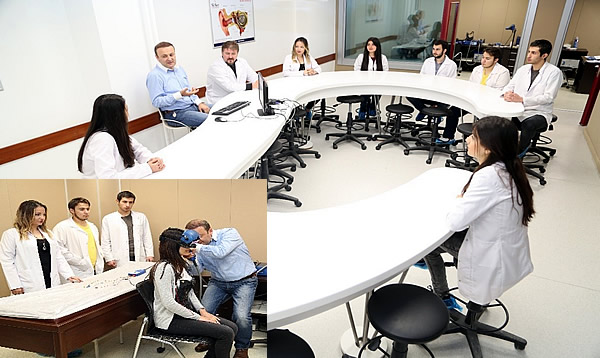
The students of this program;
Having been designed on the purpose of carrying out the applications of audiology bachelor's degree education and audiometry associate's degree education, the audiology laboratory consists of adult, pediatric and autoplasty laboratories equipped with modern devices in accordance with the requirements of the age for the purpose of making hands-on training on topics such as
- Determination, evaluation and rehabilitation of hearing and balance problems,
- Prevention of hearing in noisy environments,
- Application and rehabilitation of hearing aid,
- Candidate evaluation, rehabilitation, programming and follow-up for cochlear implant,
- Identification and evaluation of motor speech disorders
Being a laboratory service that helps the determination of diagnosis and treatment of ear diseases after an ear-nose and throat specialist examines the patient, audiology tests are performed according to the request of a specialist.
Skills Gained from Applied Education
The following devices and equipment are used in clinical evaluation:
- Clinical high-frequency audiometer device: It test high frequencies and determines whether the use of ototoxic drugs, in particular, damages the ear.
- Combined Audiometry Device: It examines the auditory system of patients by determining the degree and type of hearing loss and doing speaking tests and supraliminer tests.
- VRA (Visual Reinforcement Audiometry) system: It visually tests hearing functions of children aged between 0-6 years.
- Tympanometry device: It tests middle ear pressure and the operation of middle ear ossicles by giving pressure from the external auditory canal.
- ABR-ASSR device: It makes measurements in details by giving audio warning to the region between auditory nerve and cortex and taking recordings in the form of waves.
- Clinical TEOAE-DPOAE device: TEOAE device is used to evaluate the hearing ability of newborns. TEOAE-DPOAE examines the operation of outer hair cells of internal ear.
- OAE (Ototacoustic Emissions): It evaluates the hearing ability of newborns.
- HI-PRO aurical PMM: It makes a real ear measurement that indicates whether the patient can benefit from the hearing device.
- Tesbox-HIT (Aurical HIT): It makes a real ear measurement.
- VNG Device: It is used for the diagnosis of patients with dizziness.
They examine pure voice and speech audiometry, perform advanced audiological examinations and they record hearing loss, type and degree of hearing loss, information regarding patient's coordination related to the results of these tests, in the test forms.
They perform child audiometry (0-6 age), vestibular tests, optoacoustic emission applications and electrophysiological tests.
They make hearing aid analysis to the patients who need hearing aid, make suggestions on the proper hearing aid by using real ear measurement (REM) systems.
They measure the environmental and workplace noises with various measurement tools.
They maintain, repair and calibrate the equipment they use or have someone do these procedures.
They give the necessary information to patients and patient relatives about the procedures to be performed.
| Laboratory Equipment (Devices and Equipment) |
Clinical high-frequency audiometer device Combined audiometry device VRA (Visual reinforcement audiometry) system Tympanometry device Tesbox-HIT (Aurical HIT) | |